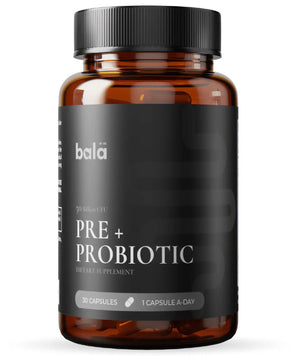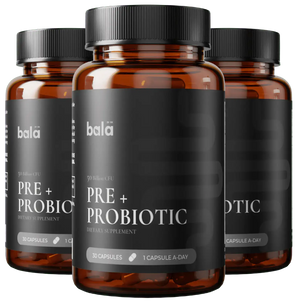Table of Contents
Introduction
Did you know that approximately 5 to 30% of patients experience antibiotic-associated diarrhea during their treatment? This statistic highlights a common yet often overlooked aspect of antibiotic use that can leave many feeling uncomfortable and anxious. Are you one of those individuals who cringe at the thought of taking antibiotics due to their potential gut-related side effects? If so, you're not alone. Many of us grapple with the repercussions of antibiotics on our gut health, leading to bloating, discomfort, and an imbalance in our microbiome.
As we navigate the complex landscape of gut health, understanding the role of probiotics becomes crucial, especially when antibiotics come into play. Probiotics are live microorganisms that, when consumed in adequate amounts, can confer health benefits to the host. They are essential in replenishing the good bacteria that antibiotics often disrupt. In this blog post, we will explore what probiotics are, why they are necessary during antibiotic treatment, and specifically, which probiotics offer the best support when combined with antibiotics.
At Bala Health, our mission is to simplify gut health and empower you with science-backed solutions. We believe that understanding the importance of probiotics can significantly enhance your well-being, particularly during antibiotic therapy. We’ll also share insights about our clinically validated probiotic, designed to support your gut health effectively.
So, if you're ready to unravel the relationship between probiotics and antibiotics and learn how to maintain a healthy gut microbiome, let's dive in!
The Importance of Gut Health
The gut microbiome is a vast ecosystem of trillions of microorganisms that play a critical role in our overall health. A balanced microbiome supports digestion, enhances immunity, and even influences our mood and mental health. However, when we introduce antibiotics into the mix, this delicate balance can be disrupted.
Why Antibiotics Affect Gut Health
Antibiotics are designed to eliminate harmful bacteria causing infections. However, they do not discriminate and can also wipe out beneficial bacteria in the gut. This disruption can lead to conditions such as antibiotic-associated diarrhea (AAD), increased gas, and bloating.
Research indicates that maintaining a healthy gut microbiome during antibiotic treatment can mitigate these side effects. This is where probiotics come into play—by replenishing the beneficial bacteria, they help restore balance and support digestive health.
What Are Probiotics?
Probiotics are live microorganisms, primarily bacteria and yeasts, that provide health benefits when consumed in adequate amounts. They are often referred to as "good" or "friendly" bacteria.
Types of Probiotics
There are hundreds of different strains of probiotics, but the most commonly studied and used include:
- Lactobacillus: Found in yogurt and fermented foods, this strain helps with lactose digestion and can alleviate diarrhea.
- Bifidobacterium: Often present in dairy products, it supports gut health and immune function.
- Saccharomyces boulardii: A yeast probiotic that is particularly effective against antibiotic-associated diarrhea.
Each strain has unique properties and benefits, making it essential to choose the right one based on your specific needs.
Why Take Probiotics with Antibiotics?
Taking probiotics during and after a course of antibiotics can help mitigate the negative impact on your gut microbiome. Here’s why it’s beneficial:
1. Reducing Antibiotic-Associated Diarrhea
Studies have shown that certain probiotic strains can significantly reduce the risk of AAD. For instance, Lactobacillus rhamnosus GG (LGG) and Saccharomyces boulardii are well-researched strains that have proven effective in preventing diarrhea during antibiotic use.
2. Restoring Microbial Balance
Probiotics can help restore the balance of good bacteria in the gut, which is often disrupted by antibiotics. By reintroducing beneficial strains, we can support digestive health and reduce bloating and discomfort.
3. Enhancing Immune Function
Our gut microbiome is closely linked to our immune system. By maintaining a healthy balance of gut bacteria, probiotics can support overall immune health, which is especially important during antibiotic treatment.
What Are the Best Probiotics to Take with Antibiotics?
When considering which probiotics to take alongside antibiotics, it’s crucial to select strains that have been clinically validated for effectiveness. Here are some of the best options:
1. Lactobacillus rhamnosus GG (LGG)
This strain is one of the most studied probiotics and has shown significant promise in preventing AAD. LGG can survive gastric acid and bile salts, making it effective in reaching the intestines where it can exert its benefits.
2. Saccharomyces boulardii
A yeast probiotic that is resistant to antibiotics, Saccharomyces boulardii can help restore gut flora balance and prevent diarrhea. It’s particularly effective for those experiencing digestive upset during antibiotic therapy.
3. Bifidobacterium lactis Lafti B94
This strain has been shown to support gut health and can be taken simultaneously with antibiotics. It helps maintain the integrity of the gut barrier and promotes overall digestive balance.
4. Lactobacillus acidophilus Rosell-52
Another effective strain, Lactobacillus acidophilus can support the digestive system and help alleviate symptoms of discomfort associated with antibiotic use.
5. Bifidobacterium bifidum
This strain is known for its ability to support gut health and may enhance the efficacy of antibiotics by reducing side effects.
How to Take Probiotics with Antibiotics
To maximize the benefits of probiotics during antibiotic treatment, consider the following guidelines:
Timing
- Simultaneous Intake: Certain strains like LGG and Saccharomyces boulardii can be taken at the same time as antibiotics without losing efficacy.
- Separate Intake: For other strains, it's advisable to take them at least 2 hours apart from antibiotic doses to ensure their effectiveness.
Duration
- During and After Treatment: It's beneficial to start taking probiotics as soon as you begin your antibiotic course and continue for at least a week after completing the antibiotics to help restore balance.
Bala Health’s Commitment to Gut Health
At Bala Health, we are dedicated to simplifying gut health through our science-backed, clean-label probiotics. Our flagship probiotic is formulated with clinically validated strains that support digestive health and overall well-being.
When you choose our probiotic, you’re not just getting a supplement; you're investing in a solution that aligns with our mission to empower you with the knowledge and tools needed for a healthier gut.
Start Your Journey to Better Gut Health
Are you ready to take charge of your gut health? Shop our clinically-backed probiotic now and experience the benefits for yourself. It’s time to feel better from the inside out!
FAQs
Can I take probiotics while on antibiotics?
Yes, taking probiotics during and after antibiotic treatment is beneficial. However, choose strains that have been shown to survive the antibiotic treatment.
When should I start taking probiotics after starting antibiotics?
You can start taking probiotics as soon as you begin your antibiotic treatment. It’s recommended to continue taking them for at least one week after finishing the antibiotics.
Are there any side effects of taking probiotics?
Most people tolerate probiotics well, but some may experience mild digestive symptoms like bloating or gas initially. These usually subside with continued use.
Can children take probiotics during antibiotic treatment?
Yes, children can take certain probiotic strains during antibiotic treatment. Strains like Lactobacillus rhamnosus GG have been studied for safety and efficacy in children.
How can I ensure I’m choosing the right probiotic?
Look for products that contain clinically studied strains and check for transparency in ingredients. At Bala Health, we prioritize science-backed formulations that meet these criteria.
By understanding the relationship between probiotics and antibiotics, we can take proactive steps toward maintaining a healthy gut microbiome, even during challenging times. If you’re looking to further enhance your gut health, we invite you to take our 3-minute Weight-Loss Quiz to find your personalized gut-health roadmap and empower your wellness journey!






